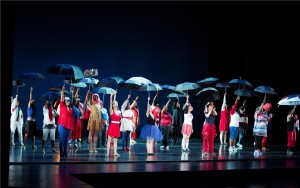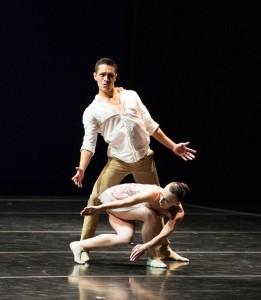The Chicago Dancing Festival (CDF), a week-long series of free dance events, came to a close Saturday night on the Pritzker Pavilion stage in Millennium Park. A large crowd turned out on a beautiful night to witness dance from some of the top companies in the country as well as artistry from fellow Chicagoans. Festival co-founders Lar Lubovitch and Jay Franke addressed the audience and introduced a casually dressed Mayor Rahm Emanuel before the show began. “Hey Chicago! Hey dance lovers!” The performance opened and closed with local talent: the After School Matters Hip Hop Culture Dance Ensemble with Nicholas Leicther’s Touch of Soul in honor of Maggie Daley and Bolero Chicago with Larry Keigwin’s homage to our sweet home city.
Nestled in between the two large local numbers was a mini tasting of the best of the best in the current dance scene. Houston Ballet performed Mark Morris’ Drink to Me Only With Thine Eyes with live piano accompaniment from Katherine Burkwall-Ciscon. Dressed in comfy looking white blowsy tops and short leggings (can I get this in black?), the dancers skipped and skimmed across the stage in a light-footed romp that showcased Morris’ deftly musical choreography. Two gala-esque performances by major ballet companies showed the range of classical ballet. New York City Ballet stars Ana Sophia Scheller and Gonzalo Garcia dazzled in the show-stopping pas de deux from Marius Petipa’s Don Quixote (1869). An early one-handed lift seemed to last forever and Scheller’s fouette run in the coda, featuring a double pirouette every second turn for the first 16 counts and one every third turn for the second half, had me jumping out of my seat. Girl can turn. Later, Sofiane Sylve and Vito Mazzeo from San Francisco Ballet danced Christopher Wheeldon’s pas de deux from Continuum (2002). The couple brilliantly danced the Sleeping Beauty pas earlier in the week and proved they are just as stunning doing more contemporary work.
Two powerhouse companies represented the same kind of choreographic range in the modern/contemporary realm. Martha Graham Dance Company performed an excerpt form Chronicle (1936), which they performed earlier in the week in its entirety. Steps in the Street physically showed just how powerful women can be. Local favorite Hubbard Street Dance Chicago danced an excerpt of Israeli choreographer Ohad Naharin’s Tabula Rasa (1986), giving an equally powerful performance in a more relaxed, freer style.
The Pritzker Pavilion is a wonderful outdoor venue that normally houses musical acts including the Chicago Symphony Orchestra. With that said, the seating isn’t ideally designed for viewing dance. The seats are directly behind one another and on a very shallow raking. My apologies to the woman seated behind me for “driving her crazy” by moving my head from side to side to see. Unless you’d like a detailed account of the woman’s hair cut and color in front of me, it was a necessary evil.
Congratulations to everyone that worked, volunteered or performed at CDF 12. It was a wonderful week full of terrific dance that won’t soon be forgotten. All free. We are lucky Chicago.


